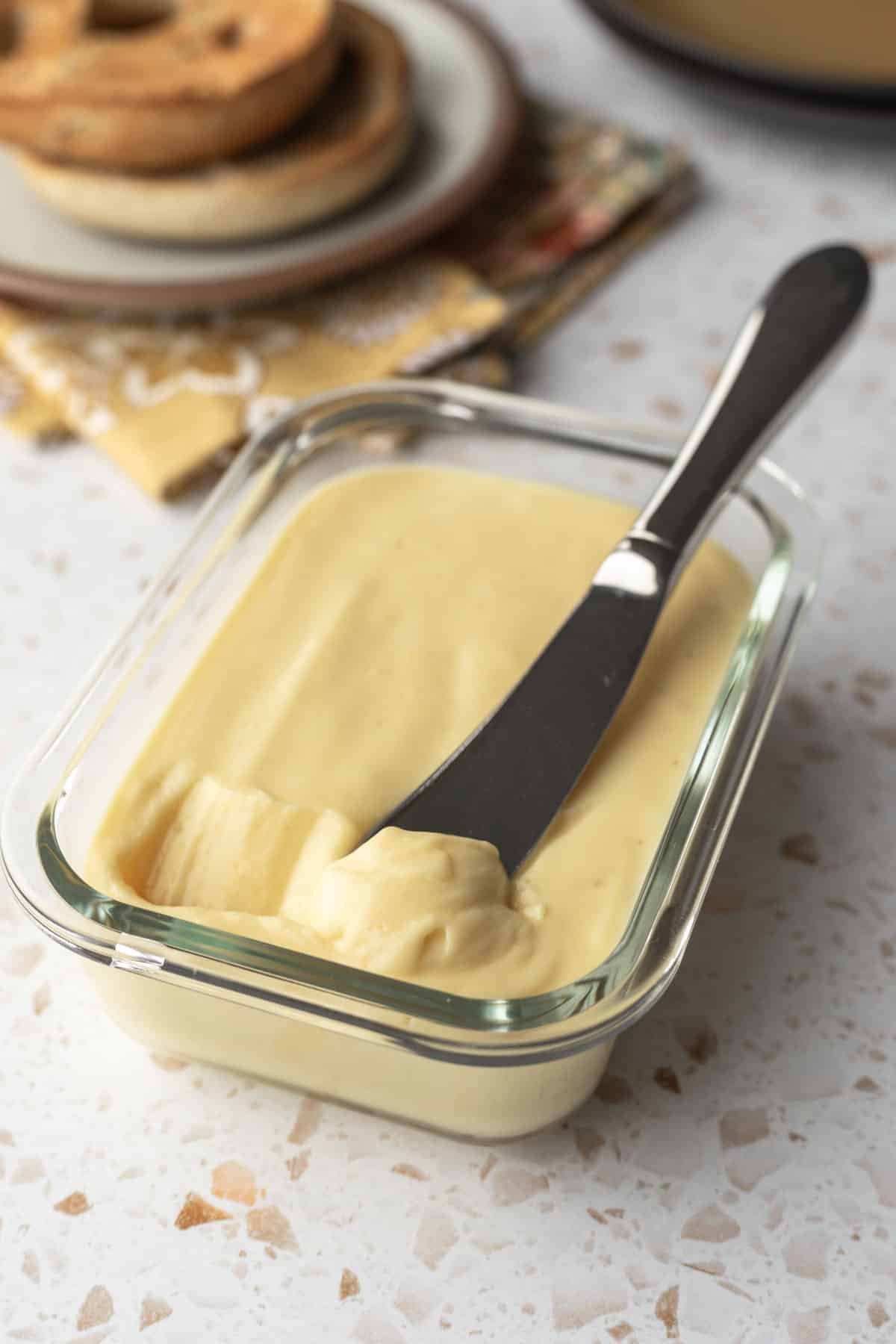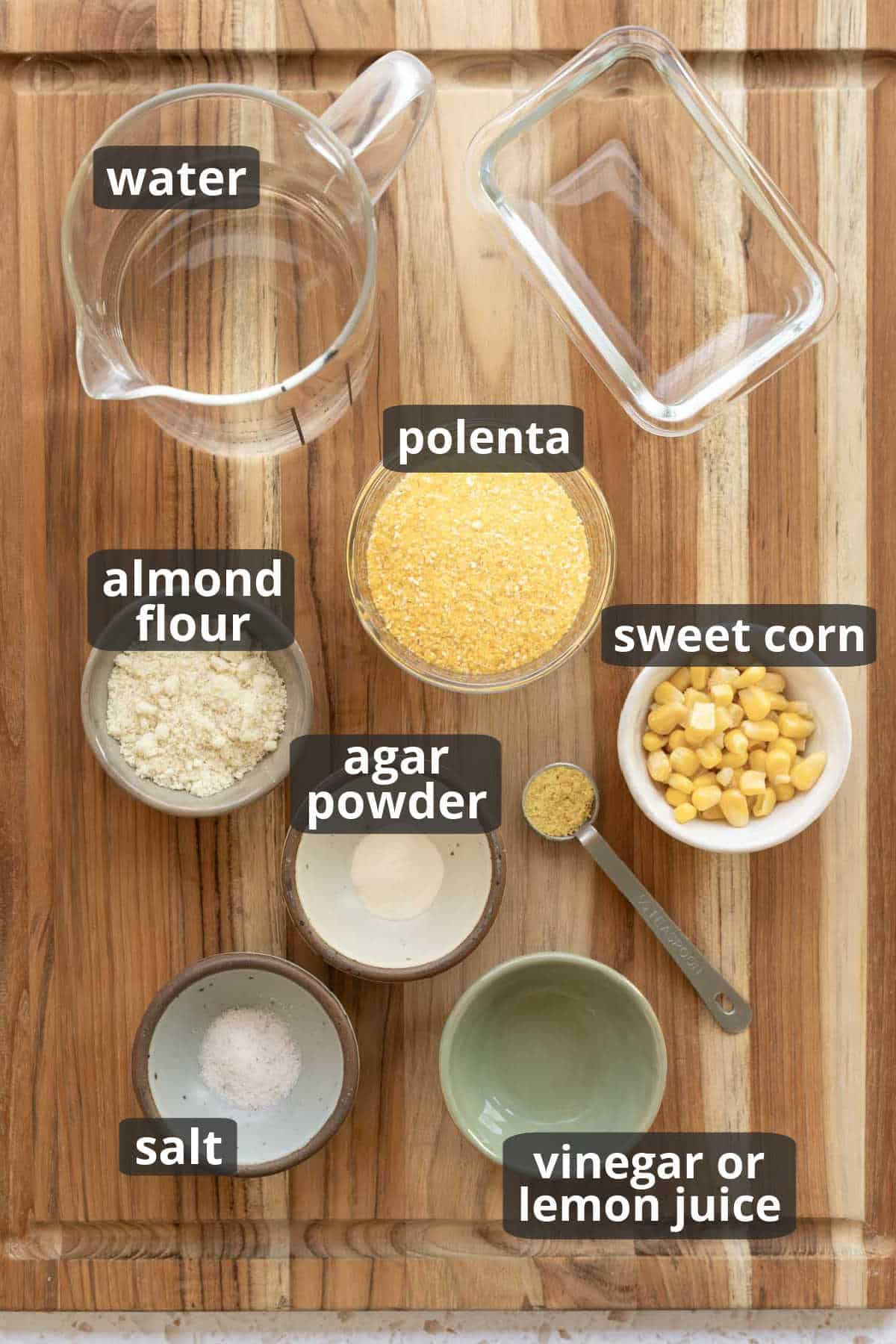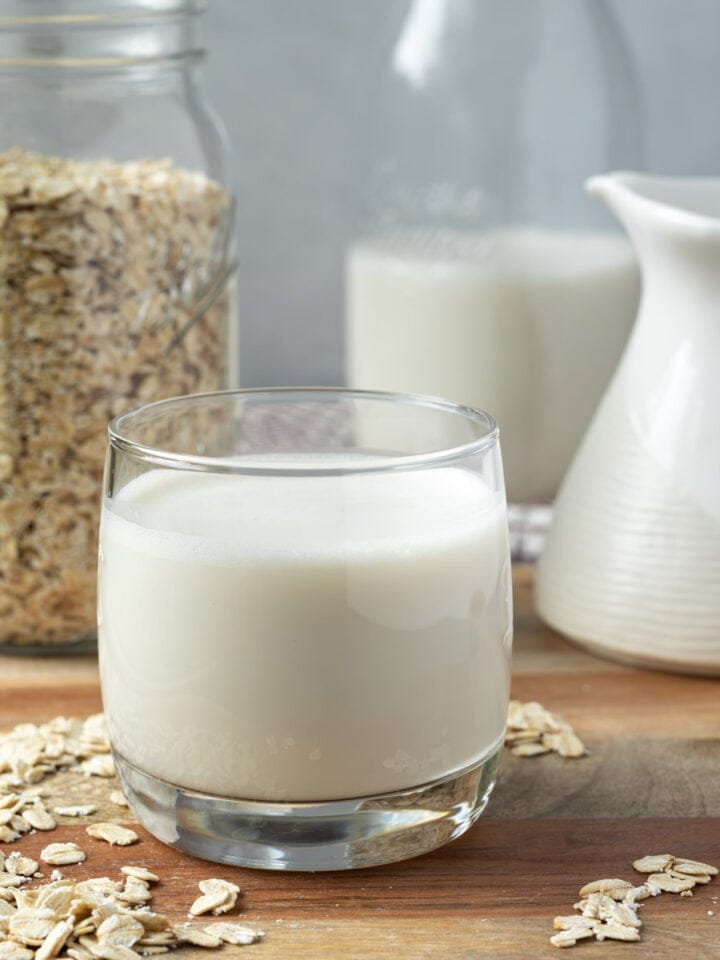This Oil-Free Vegan Butter is a healthy plant-based alternative to dairy-based buttery spreads. You can schmear it on your morning bagel, slather it on corn on the cob, stir it into mashed potatoes, and so much more! It's low-fat, low-calorie, free from gluten and soy, and easy to make in just 15 minutes!

It's amazing how many things can be used as a base for plant-based butter alternatives.
Various oils, cashews, soy milk, and cauliflower have become quite common in a number of recipes.
But what about corn?
Yes, corn! If you've read my vegan story, you know how corn-obsessed I am! If you're also a fan, be sure to check out my oil-free cornbread, jalapeno cornbread muffins, vegan corn pudding, and air fryer tortilla chips next.

I enjoy exploring healthier ways to re-create classic dishes and ingredients. I previously experimented with a few different ways to make oil-free vegan butter, including using cooked cauliflower like Anna of Cooking With Plants did in this video.
But with each experimental batch it just seemed like something was missing and I was never quite happy with the results.
Anyway, after seeing a recipe for plant-based butter using cornmeal by Dr. McDougall, I was inspired to use one of my favorite corn-based ingredients - polenta!
With its natural buttery flavor, I knew it would be delicious. If you love polenta, be sure to try my slow cooker polenta recipe. In fact, you can even stir this vegan butter right into it!
Aside from Dr. McDougall's butter recipe, I also drew inspiration from a recipe a woman shared in a WFPB facebook group I'm in. She used millet, which I also love. I haven't tried her recipe yet but probably should!
But this corn butter turned out so delicious I couldn't wait to share it with you!
Jump to:
Why You'll Love It
- This oil-free vegan butter is made with affordable, pantry-friendly ingredients and easy to whip up in minutes!
- With no coconut oil, no palm oil, or any oil at all for that matter, it's a great low-fat alternative to regular vegan butter.
- In fact, per ¼ cup serving, it contains just 25 calories and less than 2 grams fat!
- There are countless ways to use it! You can use it anywhere you'd typically use a store-bought vegan buttery spread.
Ingredients

For the full recipe and quantities, see the printable recipe card below.
- Yellow Corn Polenta - This serves as the base for the butter and adds a natural yellow color. You'll want to use dry/uncooked polenta.
- Garlic Powder - Just a pinch adds a touch of umami flavor and complexity to the mixture.
- Agar Agar Powder - This plant-based gelling agent made from seaweed behaves similarly to gelatin and helps give this buttery spread a firmer consistency. If you don't have agar agar or cannot get it, the butter will still thicken somewhat in the fridge thanks to the polenta. You can also try using tapioca starch instead.
- Blanched Almond Flour - This adds a very tiny amount of fat which I realized is what was lacking in my other attempts at making an oil-free butter. Almond flour not only helps make blending a bit easier, it also has a light buttery flavor.
- Sweet Corn Kernels - A small amount adds a touch of sweetness without tasting TOO much like corn. I used frozen for convenience.
- Nutritional Yeast - Optional for adding a hint of savory flavor.
- Lemon Juice & Apple Cider Vinegar - These provide acidity and a slight tang to the recipe. I like to use both so that their specific flavors aren't too noticeable.
- Sea Salt - Saltiness is key in creating a buttery taste. If you plan to use your butter on sweeter dishes such as pancakes, waffles, or muffins, you may want to use a bit less salt.
How to Make Oil-Free Vegan Butter
Here's a quick overview of the process. You can see it's pretty simple!
Want to save this recipe? 📩
Keep an eye out for more delicious recipes. Unsubscribe anytime.

Add the polenta to a high-speed blender and cover with a piece of plastic wrap to help prevent it from sticking to the inside of the blender lid. Trust me - this really helps! Then place the lid on top.

Blend the polenta for a few seconds so that it's broken down into smaller bits. This helps it cook more quickly. You'll have some larger bits and some powdery cornmeal, which is fine.

Whisking frequently, cook the polenta until thick and creamy. Whisk the agar agar and water together in a small bowl. Pour it into the saucepan and return to a low boil. Continue whisking and cook for a bit more to activate the agar. Remove from the heat and add the remaining ingredients.

Rinse out the blender and add the polenta mixture. Blend until smooth, and then pour the oil-free butter into a mold/container.

Refrigerate uncovered until cool. Then cover the dish and keep refrigerated until ready to use.
Expert Tips
- Breaking the polenta into smaller pieces by blending it first helps it cook much more quickly.
- Use caution while whisking the polenta mixture as it tends to sputter out of the pan and can burn you.
- You'll want to transfer the blended butter mixture immediately after blending since agar begins to set very quickly.
Variations and Substitutions
- Polenta - You can use cornmeal in place of the polenta, however, when I tested this, we found the flavor to be too strong and more bitter than the polenta.
- Almond Flour - If you are allergic to almonds, feel free to swap the almond flour for raw cashews or a tablespoon of cashew butter. If you are completely nut-free, you can use raw sunflower seeds instead.
- Sea Salt - Feel free to swap the sea salt for miso if you prefer, which will add a bit more of an umami flavor.
- Buttery Flavor - Give your vegan butter even more buttery flavor by adding a hint of this vegan butter flavor extract. A little bit goes a long way!
Serving Suggestions
You can use this dairy-free butter as a spread for dinner rolls, toast, oil-free vegan biscuits, bagels, banana bread, pancakes, waffles, and more!
It's also great on top of baked potatoes, corn on the cob, and steamed veggies.
You can also mix it into mashed potatoes, rice, quinoa, or even pasta sauces to add creaminess.
Storing
This oil-free vegan butter spread will keep in the refrigerator for up to 4 days. I don't recommend freezing it as the water tends to separate after thawing.
FAQ
Similar to store-bought vegan buttery spread and even dairy-based buttery spreads, this homemade version is not recommended for baking. It contains more moisture, and the fat content is too low to use it as a sub for butter in baked goods.
While you can use it to sauté veggies, it's important to note that it will add a bit of creaminess and doesn't melt exactly like butter. It will, however, add nice flavor to your veggies!
I hope you enjoy this healthy butter alternative! If you try the recipe be sure to leave a comment below. And if you're on instagram, tag a photo of your oil-free vegan butter spread with @myquietkitchen. I love seeing what you're making!
More Vegan Dairy Alternatives
Recipe

Oil-Free Vegan Butter Spread
Equipment
Ingredients
- ¼ cup yellow corn polenta, dry/uncooked - see Note 1
- 1¼ cups water, divided
- pinch of garlic powder
- 1 teaspoon agar agar powder - see Note 2 for options
- 2 Tablespoons blanched almond flour - see Note 3
- 1½ Tablespoons sweet corn kernels - I use frozen for convenience
- ½ teaspoon nutritional yeast, optional
- 1 teaspoon lemon juice
- ½ teaspoon apple cider vinegar
- ½ teaspoon fine sea salt - can reduce if you plan to spread on sweet dishes like pancakes
Instructions
- Place dry polenta in a high-speed blender and cover with a piece of plastic wrap (this helps contain the powdery bits and prevents a mess from sticking to the inside of the blender lid). Place the lid on top of the plastic. Starting on low, quickly increase to high speed, and blend the polenta for about 10 seconds (breaking it into smaller pieces helps it cook more quickly).
- Pour the polenta into a small saucepan. Add a tiny pinch of garlic powder, 1 cup of water, and whisk well. Turn the eye to medium heat and bring to a low boil, whisking frequently. Reduce heat to low, and continue to whisk frequently - careful, as it tends to sputter and spit and can burn you! Cook for about 7 minutes or until thick and creamy.
- In a small bowl, whisk the agar into the remaining ¼ cup water. Pour this into the pot and return to a low boil. Continue whisking and cook for about 30 seconds to activate the agar. Remove from heat and whisk in the almond flour, corn, nutritional yeast, lemon juice, vinegar, and salt.
- Rinse out the blender, and add the polenta mixture. Cover and starting on low speed, gradually increase to high. Blend until completely smooth. Taste and adjust salt or lemon, if desired. Note that agar begins to set quickly. So as soon as you're finished blending, pour the corn butter into a mold/container.
- Refrigerate uncovered until cool, then cover and keep refrigerated until ready to use. Find serving suggestions and other helpful tips in the post above.
Notes
Estimated Nutrition (per serving)
Nutrition information is an estimate and will vary depending on the exact amounts and specific products and ingredients used.








Tracy says
I was super excited about this! I just made my first batch, but going into the fridge it still seemed a bit grainy. Does not look butter smooth as in your picture. Darn, Where did I go wrong??
Lori Rasmussen says
Hi Tracy, it sounds like it just needed to be blended more and/or possibly cooked longer to make sure the polenta was soft.
Shannon Friziellie says
Wow! This turned out great. I'm so impressed. I tweaked it just a bit since I have a huge aversion to lemon flavor in anything "cheesy or savory." So I always omit lemon in recipes. I replaced it with a tsp of oat milk & I used 1 tbsp of fresh ground cashew butter instead of almond flour since I didn't have any on hand. Came out perfect, thank you!
Robert says
I’ve been looking for and taste testing vegan butter substitutes for years, and now I’ve finally found one I like. This recipe helps complete my morning coffee and toast/bagels, without the oils found in commercially prepared products. Awesome!
JV says
We have made this a couple of times but the corn and the polenta need to be ground finer. So, since I’m lazy, I substituted corn flour for the polenta and baby food corn purée for the corn kernels. OMG! So good!!
Brenda Propp says
Has any one found a way to preserve it longer?
Lori Rasmussen says
Not that I know of. You could certainly try freezing it, but expect some separation after thawing. None of the oil-free butter recipes I've seen will be safe to keep longer than other types of leftover prepared foods. As you probably know, dairy butter only keeps because it's so low in water (and more than 80% fat).
Marie says
Hi Brenda! I cannot use vinegar of any kind (have many friends who cannot or do not either) and experimented with many recipes. With this, I substitute the vinegar with Vitamin C powder (ascorbic acid) by EarthBorn Elements. Dissolve 1/2 to 3/4 teaspoon in the lemon juice first. It does act as a healthy, natural preservative and I have kept my own vegan butter recipe I created for 3 weeks, and other cooks' recipes. Sometimes it doesn't last that long as it is eaten up. :-)) I use Vitamin C powder a lot. I created a sub red wine vinegar mixture of 4 Tbsp fresh lime juice, 2 Tbsp fresh lemon juice, 4 Tbsp tart cherry juice, and 1/8 tsp Vitamin C powder for a salad dressing and a gourmet chef did not know the difference. It really tasted better than the real thing. :-)) Anyway, I did talk with a lady at EarthBorn and theirs is made from fruits/vegetables; I buy it by the gallon bucket, it keeps good and for a long time. Hope this helps.
Alison says
Add a little bit of miso. The bacteria in it discourages bad bacteria from growing.
Rose_Anne says
Tried it, and love it!
Great directions, easy to make, and very tasty.
We all have slightly different taste buds, I prefer a bit more salt, but other than that? Perfect.
Thank you!
Tracey says
This turned out realllllllly good.
I used cornmeal because it’s what I had and I googled that polenta is basically the same as cornmeal but a coarser grind.
I also skipped a step and just dumped everything but the agar agar and reserved water in the blender and blended smooth all at once.
Followed the recipe the same the rest of the way.
Turned out beautifully!
Super creamy and very buttery feeling on the tongue.
Thank-you!
Rose_Anne says
Bless your heart, Lori! Thank you very much for persevering with this, and I can't wait to try.
Lori Rasmussen says
You're so sweet, thank you! I really hope you enjoy it.
Jane says
I have a question - what does the almond flour do for the mixture? Is it necessary in the final product?
Thank you
Lori Rasmussen says
Hi Jane - you can certainly leave it out with no problem. Other oil-free butter recipes I've seen don't add any fat. Since butter is nearly all fat, I figured it was an opportunity to mellow the corn flavor a bit. I'm sure it helps it thicken slightly, too, since almond flour absorbs liquid.
Pam says
This sounds intriguing. I need to purchase some polenta. Lori, what brand of polenta did you use/prefer? I've tried different brands in the past and they each taste different. Some are stronger tasting, similar to as you noted for cornmeal.
Thanks!
Lori Rasmussen says
Hi Pam - you're so right! I talked about the polenta in my last recipe and then forgot to mention it here. Right now I'm using Bob's Red Mill, which is usually pretty easy to find. I don't know why, but their polenta tastes better to me than the medium grind cornmeal. Here since there aren't a lot of other flavors going on to mask that bitterness, we were surprised what a difference there was between the two batches.